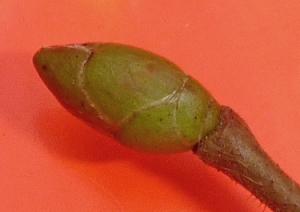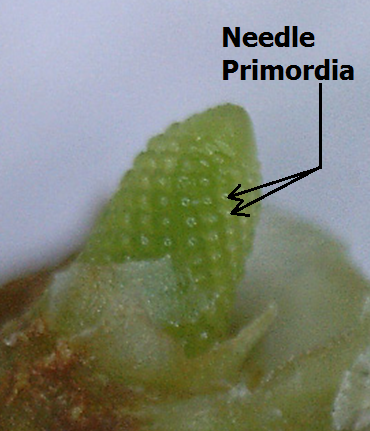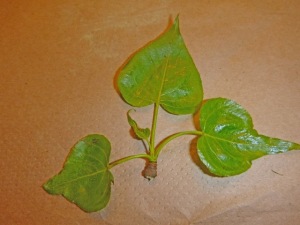Buds: A Bridge to the Future
Buds: A Bridge to the Future
By Bruce Rottink, Volunteer Nature Guide and Retired Research Forester
Winter is a tough time for the woody plants at Tryon Creek State Natural Area (TCSNA). The air gets both colder and, when the temperature dips below freezing, much drier. Most of the plants stop growing, and some shed their leaves. However, the plants have to be prepared for the next growing season. To prepare, they form buds as a “bridge” to the future. By September the buds are a conspicuous feature of woody plants at TCSNA .
A woody plant’s bud might merely look like a hard little blob on a branch, like this bud of a European hazel (Corylus avellana) growing near TCSNA’s main parking lot.
But the buds of TCSNA’s woody plants are actually quite interesting.
So what exactly is a “bud”?
At the tip of each branch is a small cluster of active cells called the apical meristem. At some point in the spring-summer-fall (it varies with different species), the apical meristem starts differentiating and forming a bud consisting of a variety of structures. These structures can be bud scales, leaves or flowers. These tiny structures rest over the winter, and come spring, they start growing. Even the tough-looking bud scales elongate a bit in the spring.
Below is a picture of a bigleaf maple (Acer macrophyllum) bud which is just starting to open. The different parts of the bud are labeled. The “scale to leaf” transition components have very, very tiny leaf parts at the tip of the scale, you’ll have to look closely.
Last spring I picked another newly opened bud of bigleaf maple which was slightly more advanced than the one pictured above. I took it apart to more clearly show the different components. In the picture below, the parts from the base of the bud are at the left hand side, and the other structures are arrayed in order, right up to the flower, which was at the tip. For completeness, at the base of the floral stem are two tiny meristems (not visible here) that will create next year’s buds.
Since the maples produce structures in pairs, one on each side of the stem, there are always an even number of scales and leaves. The flower is an exception to this rule. The “scale to leaf” transition phase is the most interesting. The leaves and flowers have a perfectly round “stem” connecting them to the branch of the plant. The “scale to leaf transition” structures are dwarf leaves supported by a flattened “stem” that resembles the bud scales in shape. These structures clearly demonstrate the plant’s flexibility when it comes to producing different parts. It’s not a clear “one thing or another” decision. (Note: Not all maple buds have these part-scale/part-leaf structures.)
Now it starts to get really interesting!
Okay that’s the basic pattern, but with dozens of different species of woody plants growing at TCSNA, we’ve got lots of variations in buds.
The first type of “weird bud” is the naked bud. This means a bud that has no bud scales. Our native cascara buckthorn (Frangula purshiana) produces naked buds as seen below. The leaves are fully exposed to the winter environment, but are very tough, and slightly hairy. If you want to see a cascara, go to Beaver Bridge. The cascara is about 5 feet upstream from the bridge on the side of the creek furthest from the Nature Center.

Naked cascara bud just starting to open in early spring
Flower Buds, Leaf Buds and Both of them!
As you saw with the bigleaf maple, some buds contain both leaves and flowers, but some contain only leaves and some contain only flowers.
Oftentimes you can tell if the bud contains flowers even before the buds open. In the picture below are two buds of Indian plum (Oemleria cerasiformis) collected from the same branch. They are just starting to expand in the spring. The big fat bud with the rounded end contains both leaves and flowers, while the skinny one contains only leaves.
Indian plum also teaches us that the term “bud break” is ambiguous at best. Below is a picture of a newly opened Indian plum “bud” containing both leaves and flowers. The young leaves including their tiny veins are clearly visible. The flowers are still contained with their own separate “buds.” So, with the Indian plum we have a bud within a bud.
The Indian plum plants are either male or female, and with rare exceptions, will have only functional male OR female flowers on a single plant.
Keeping it all together
In contrast, some plants have both male buds and female buds on the same plant. Red alder (Alnus rubra) is a good example. The alder tree has buds that only contain leaves, other buds that only contain female flowers, and other buds that only contain male flowers. The photo below shows the three different kinds of overwintering alder buds.
How else can the buds be different?
One of the most important ways that buds are different is that some species have determinate, buds and other species have indeterminate buds. Overwintering determinate buds contain all the organs (like leaves, needles, flowers, whatever) that will appear the following year. Indeterminate buds hold only a few of the organs that may appear next year.
A good example of a determinate bud is our Douglas-fir (Pseudotsuga menziesii). In the winter, all of the needles that will grow out of the Douglas-fir bud the next year are already present in primitive, miniature form call “primordia.” Pictured below is a Douglas-fir bud which I collected in late August and stripped off all its scales. Each little needle primordium will turn into an actual needle early next spring. Two of the primordia are indicated with black arrows. All of the needles destined for the 2016 branch are represented by a little bump of tissue. This entire green structure is approximately 2 mm (1/12”) in diameter. For plants with determinate buds, it is easy to see why the environment of one year is so important in influencing the growth of the plant in the following year.
In contrast, TCSNA’s black cottonwood (Populus balsamifera var. trichocarpa) has an indeterminate bud. For cottonwood this typically means that there are three or four relatively big pre-formed leaves that overwinter in the bud. Come spring, these leaves will expand very quickly, and start producing sugar for the plant. If the weather conditions are good, the apical meristem will create another leaf from scratch, and when that is done, the tree might produce a couple of more leaves, etc. This is why for indeterminate plants, shoot growth in any one year is profoundly affected by the environment in the current year, not the previous year!
Below is a whole cottonwood bud, and the same bud with the scales removed. In the second photo you can easily see two preformed leaves, two more are hidden on the backside of the bud.
The photo below shows a single, preformed cottonwood leaf in the bud. The light streak is the main vein which will go down the center of the mature leaf.
The photo below is of a black cottonwood shoot not too long after it emerged from the bud. You can see the 3 large leaves which were preformed, and the fourth, smaller, leaf which formed after the bud broke.
For the woody plants at TCSNA, the overwintering buds ARE the future. It is amazing that the fate of something as large as a tree rests within the tiny buds which bridge the gap between the growing seasons. All things considered, buds deserve a lot more attention than they receive.
Posted on October 1, 2015, in Plants & Wildlife, Trees and tagged Blooming, Buds, Cottonwood, Douglas-fir, European Hazel, flowers, forest, Maple, Plant reproduction, plant tissue, plants, Trees, Tryon Creek State Natural Area, Winter. Bookmark the permalink. 1 Comment.












Lovely, creative, relevant. Thanks Bruce